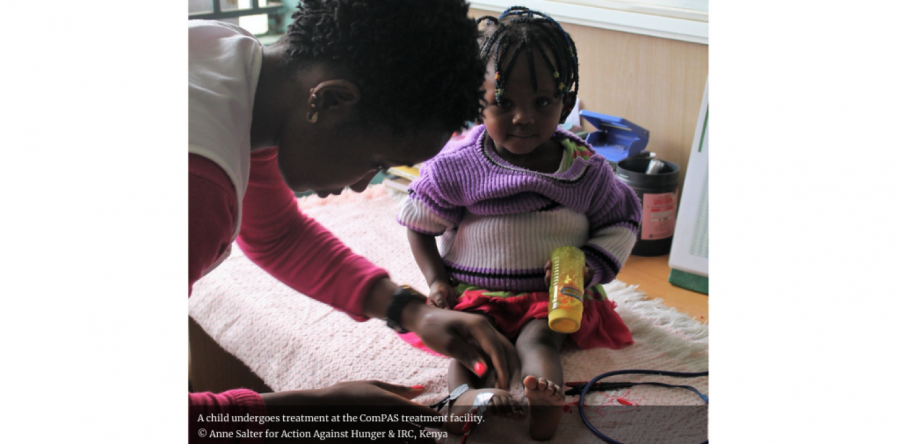
A new streamlined approach to treating acute malnutrition is as effective as standard treatment but will free up funds to reach more children with life-saving care, according to new research published in PLOS Medicine.
The study was led by the International Rescue Committee (IRC), the London School of Hygiene & Tropical Medicine (LSHTM), and Action Against Hunger. It was supported by the No Wasted Lives Coalition, the Ministries of Health in Kenya and South Sudan, UNICEF and WFP, with funding from the U.S. Office of Foreign Disaster Assistance (OFDA) and Children's Investment Fund Foundation (CIFF).
The research team tested a simplified, combined protocol for the treatment of malnutrition in young children (6-59 months) through a cluster randomised control trial in Kenya and South Sudan. The research team found that this streamlined protocol, involving a single diagnostic criteria and a single therapeutic food product, led to similar proportions of children recovering from malnutrition as the standard approach. Moreover, it was more cost-effective -$123 cheaper per child recovered.
This is important as nearly 50 million children suffer from acute malnutrition at any given time yet only 25% get access to potentially life-saving treatment.
Malnutrition contributes to the deaths of approximately three million children under the age of five each year. Experts anticipate a rise in the number of malnourished children in 2020 as a result of COVID-19. The World Food Program recently projected that the pandemic could double the number of people suffering acute hunger to more than a quarter of a billion by December 2020.
Currently, severe and moderate acute malnutrition (SAM and MAM) are treated with separate products and protocols, in separate programs managed by separate UN agencies.
Lead author Jeanette Bailey, Nutrition Research and Innovation Lead at the IRC and London School of Hygiene & Tropical Medicine researcher, said: "The current system for treating acute malnutrition is complex and costly, and fails to reach the majority of children. Many children are diagnosed only after they have deteriorated to the most severe and deadly forms of acute malnutrition. Simplified approaches could encourage earlier detection and treatment, and ultimately save lives."
Dr. Charles Owubah, CEO of Action Against Hunger, said: "The world needs a better way to deal with malnutrition, and research like this is key to creating it. By innovating with easier, more cost-effective treatment delivery, we can reduce the burdens on health systems and maximise scarce resources."
The treatment of SAM is currently supported by UNICEF and provides ready-to-use therapeutic foods (RUTF) for medically uncomplicated cases in outpatient therapeutic programs. This involves weekly visits, often on foot, to a health centre to receive rations of RUTF and essential medicines.
Treatment of MAM is supported by The World Food Programme which provides ready-to-use supplementary foods or fortified blended flours for use in additional feeding programs which sees children bi-weekly.
In this study, the treatment for children aged 6-59 months was unified into one protocol, with simplified diagnostic criteria and a single therapeutic food product. Between May 2017 and March 2018, more than 4,000 children were enrolled in the study, approximately half received standard treatment, half received combined protocol treatment.
At the end of the trial period the research team assessed nutritional recovery defined as children having a mid-upper arm circumference measurement of more than 12∙5cm and no edema for two consecutive visits (weekly for SAM and bi-weekly for MAM).
The research team found nutritional recovery in the combined protocol (76.3%) matched that seen through standard treatment (73.5%). No difference was also seen in the number of deaths, children who didn't respond to treatment, children who were transferred to another facility for more treatment and children stopping treatment early by missing visits.
To assess cost-effectiveness, the researchers calculated costs using accounting data, interviews with key informants, and survey questionnaires given to a subset of staff and all caregivers.
The amount of ready-to-use food required for a child with severe malnutrition to reach full recovery was less in the combined protocol (122 vs 193 sachets), and the combined protocol was $123 less per child recovered ($918 v $1,041).
Dr Marko Kerac from LSHTM and study senior author said: "Prolonged and severe emergencies like the COVID-19 pandemic risk increasing global food insecurity and malnutrition and add further strain to already fragile health systems. This study is an important step towards protecting young lives in states affected by crises or conflict, now and in the future."
These results provide new evidence to support recent moves by key actors within the UN system encouraging governments and humanitarian agencies to use this simplified protocol in nutrition programs affected by COVID-19.
The authors acknowledge limitations of their study including the combination of two different contexts in a single estimate of effectiveness, a study population that was primarily between 6-24 months thereby limiting generalizability to older children, and high defaulting caused by contextual factors that affected both arms of the trial equally.
The researchers say further research is now needed to test this new protocol in different contexts for managing acute malnutrition.
Publication
Jeanette Bailey, Charles Opondo, Natasha Lelijveld, Bethany Marron, Pamela Onyo, Eunice N. Musyoki, Susan W. Adongo, Mark Manary, Andre´ Briend, Marko KeracID. A simplified, combined protocol versus standard treatment for acute malnutrition in children 6-59 months (ComPAS trial): A cluster-randomized controlled non-inferiority trial in Kenya and South Sudan. PLOS Medicine. DOI:10.1371/journal.pmed.1003192






